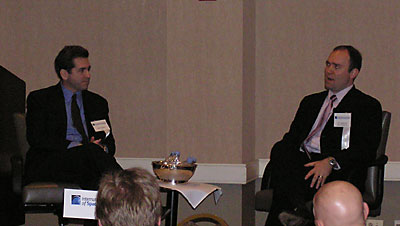Selling dreams: the promise and challenge of space tourismby Jeff Foust
|
| “The holy grail of Space Adventures when it was founded was to provide a suborbital experience,” said Anderson. “We envisioned that we would have suborbital flights long before commercial orbital flights.” |
On March 11 Eric Anderson, the CEO of Space Adventures, spoke about his company and the space tourism industry in general at an event sponsored by the International Association of Space Entrepreneurs in suburban Washington, DC. During an extended on-stage interview with CNN space reporter Miles O’Brien—who spent time in Russia in the late 1990s in a failed effort to arrange a flight to the former Mir space station—Anderson discussed the history and future of his company’s space tourism ventures as well as the numerous challenges the industry in general faces.
Suborbital vs. orbital
Space Adventures is usually recognized as an orbital space tourism company. The company brokered the flights of both Tito and Shuttleworth, and has been closely associated with the most recent efforts to send tourists to the ISS. However, Anderson said, that focus on orbital tourism is something of a historical accident.
“The holy grail of Space Adventures when it was founded [in 1997] was to provide a suborbital experience for $100,000 or so,” he said. “We envisioned that we would have suborbital flights long before commercial orbital flights.”
What changed, of course, was the ready availability of seats on Soyuz flights. “Even we did not know or believe at that point that there really was as large a market as we potentially found,” he said. “Even though it’s still a small market, we didn’t realize it was as large as it was for people who were willing to pay $20 million to fly to a space station.” Anderson later said that there are “a dozen or two serious candidates” his company has been in contact with regarding trips to the ISS.
While doing orbital tourist flights long before their suborbital counterparts became available might seem like a backwards approach, Anderson said it has proven to be effective for the industry in general. “I think the most important thing orbital flights did for the industry is that it set in people’s minds out there that space tourism was no longer something that was only in the future,” he said. “When you’ve broken down that wall, it makes a huge difference. Space tourism is no longer something that people talk about only in the context of science fiction.”
Although no tourists flew to ISS last year, because of the Columbia accident and other issues, Anderson believes that the near future will see a steady stream of one or two tourists a year flying to the ISS. “That could include sponsored projects, it could include ‘Survivor’-type television shows everyone has heard about, it could include rich scientists,” he said. The company’s Russian partners are even more interested now in such projects “because they see an uncertain future for the space station beyond 2010 or 2011.”
| Commercial suborbital space tourism “could happen in two years, but three years is more realistic,” Anderson said. |
When O’Brien asked about the potential for tourist flights on China’s Shenzhou spacecraft, Anderson said he was interested but noncommittal. “The Chinese have said many, many times that they see space as a long-term commercial market,” he said. “I think overall for the industry it will have a positive effect; at least it is another competitive force out there, at best it could be a provider.” He said company representatives have visited China in the last year and a half and were very impressed with China’s space facilities.
The success of orbital tourist flights has overshadowed to a significant degree the suborbital market. During the interview O’Brien even questioned how interesting such flights would be, given that for $100,000 people would get less than 15 minutes of weightlessness and fly to only 100 kilometers. “You come back and, boy, you’re great at a cocktail party. Is that it?” he asked.
Anderson remains optimistic about the prospects of suborbital tourism. “By experiencing this suborbital flight you will reach astronaut altitude and you will join that very exclusive group of people,” he said. “That’s something people will pay for. It’s a lot of money, but there are a lot of millionaires in the world who are willing to spend their money to make their lives more interesting and have some adventure.”
He said Space Adventures hasn’t focused much on really marketing suborbital spaceflight because it will be some time before commercial flights are available. “Even though Burt Rutan is likely to fly his vehicle this year, maybe in the next few months, it’s still going to take a few years,” he said. “It could happen in two years, but three years is more realistic.”
